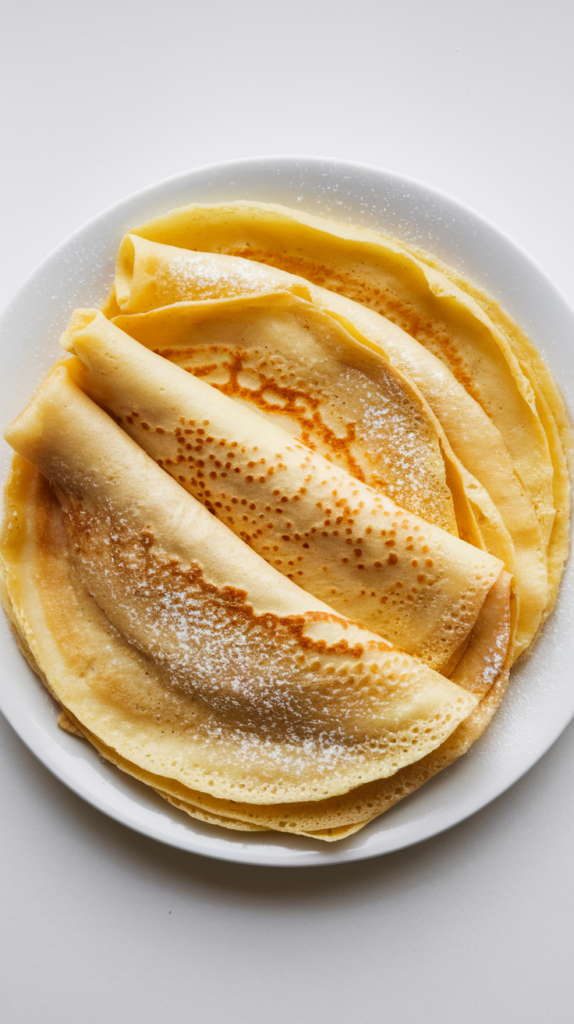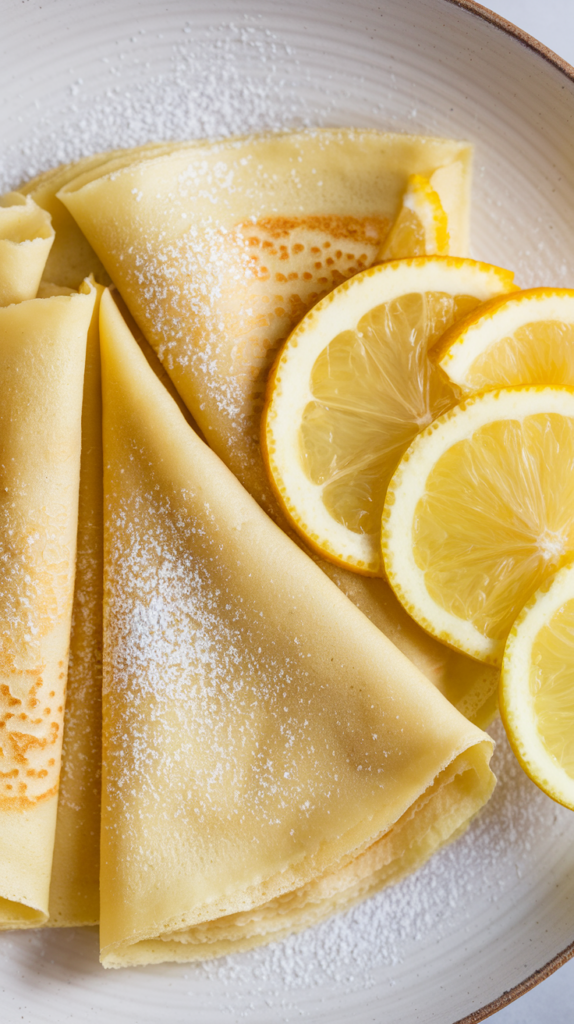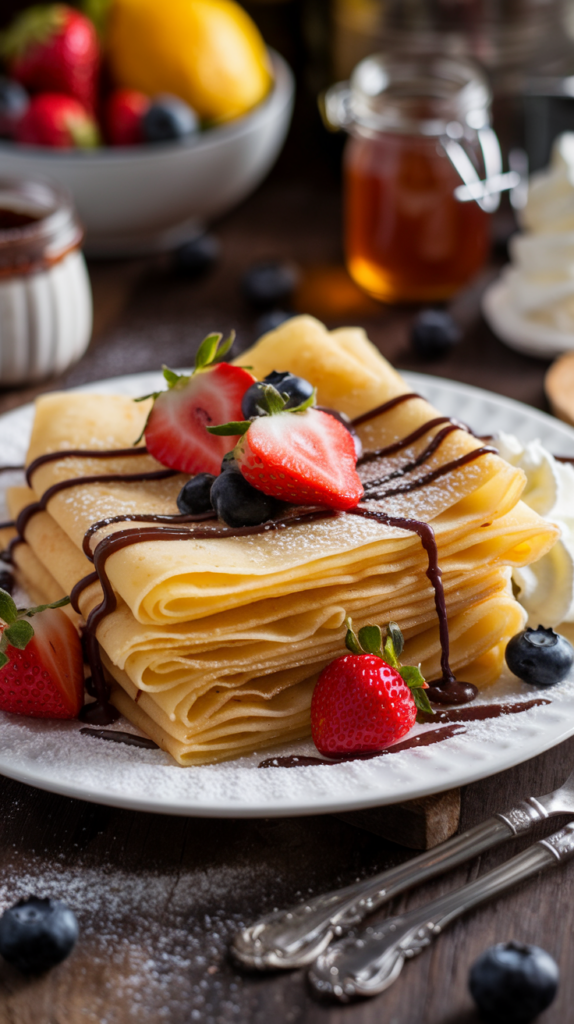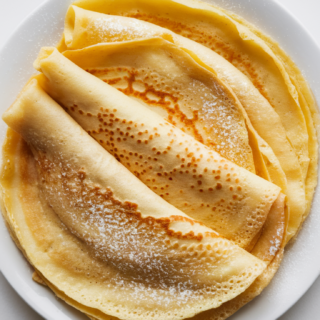Picture this: a plate of warm, golden crepes, folded into elegant triangles or rolled into delicate cylinders, whispering promises of buttery richness and endless filling possibilities.

That’s the magic of French crepes!
Whether you’re a sweet tooth dreaming of Nutella and strawberries or a savory fan drooling over ham and cheese, crepes are the ultimate blank canvas.
Why do I adore them so much? Crepes are versatile, impressive, and surprisingly easy to make.
Plus, they have this *je ne sais quoi* that makes you feel oh-so-French, even if your only connection to Paris is a Netflix binge of Emily in Paris.
Ready to dive in? Let’s get flipping!
In this post, you'll find...
A Brief History and Origin of Crepes
Crepes originated in Brittany, a picturesque region in northwest France, known for its charming cobblestone streets and rolling green hills.

These thin pancakes were born out of practicality: leftover buckwheat flour (used for savory galettes) was transformed into a batter, cooked on hot stones, and voilà—crepes were born!
Fun fact: In France, February 2nd is La Chandeleur, or “Crepe Day.” Families gather to make crepes and—get this—flip them while holding a coin in the other hand for good luck.
It’s a quirky tradition that gives you another reason to love this dish!
Ingredients for Classic French Crepes
- 1 cup (125g) all-purpose flour
- 2 large eggs
- 1 ½ cups (375ml) milk
- 2 tablespoons (30g) melted butter, plus more for the pan
- 1 tablespoon (15g) sugar (optional, for sweet crepes)
- A pinch of salt
- 1 teaspoon vanilla extract (optional, for added sweetness)
Breaking Down the Ingredients
- Flour: The foundation of your crepes, all-purpose flour ensures a smooth batter. Sift it if you want to avoid pesky lumps!
- Eggs: These are your batter’s binding agents and the key to that beautifully elastic texture.
- Milk: Provides the liquid base, making the batter thin enough to spread into that signature crepe thinness. Use whole milk for a richer taste.
- Melted Butter: Adds richness and prevents the batter from sticking to the pan. It’s like a built-in non-stick insurance policy.
- Sugar (optional): Sweetens the batter for dessert crepes. You can skip it for savory versions!
- Salt: Enhances all the flavors—don’t skip this tiny-but-mighty ingredient.
- Vanilla Extract (optional): A fragrant touch for sweet crepes.
How to Make Perfect French Crepes

Step 1: Mix the Batter
Start with a medium-sized mixing bowl. Add your flour and a pinch of salt, creating a little well in the center. Crack in your eggs like a pro chef—one-handed, if you’re feeling fancy! Slowly whisk, gradually incorporating the flour into the eggs.
Now, pour in the milk in a steady stream while whisking continuously. The goal? A smooth, lump-free batter. Add your melted butter, sugar, and vanilla extract, then whisk again until the batter looks silky and irresistible. If you spot lumps, don’t panic—just strain the batter through a sieve.
Pro Tip: Let the batter rest for 30 minutes. This lets the gluten relax, ensuring tender, melt-in-your-mouth crepes.
Step 2: Heat the Pan
Grab a non-stick skillet (8-10 inches works best) or a crepe pan if you’re feeling extra authentic. Heat it over medium heat, then brush it lightly with butter. The pan is ready when a drop of water sizzles and dances on the surface.
Pro Tip: Use a pastry brush or paper towel to ensure a thin, even layer of butter. Too much butter can cause your crepes to crisp up too much.
Step 3: Cook the Crepes
Ladle about ¼ cup of batter into the center of the hot pan. Immediately lift and tilt the pan, swirling the batter to coat the surface in a thin, even layer. You’re aiming for the thickness of a sheet of paper—channel your inner artist here!
Cook for 1-2 minutes, or until the edges start to lift and the bottom is golden brown. Flip the crepe with a spatula (or your fingers, if you’re daring) and cook for another 30 seconds to 1 minute on the other side. Transfer to a plate and cover with a clean kitchen towel to keep warm.
Pro Tip: The first crepe is usually a dud—it’s the sacrificial pancake that helps you perfect your pan’s heat and butter level. Don’t sweat it!
Step 4: Stack, Fill, and Serve
Repeat the process with the remaining batter, adding more butter to the pan as needed. Stack the cooked crepes on a plate. When you’re ready to serve, fill them with your favorite sweet or savory toppings.
- Sweet Ideas: Nutella and banana, fresh berries with whipped cream, or a classic sprinkle of lemon juice and sugar.
- Savory Options: Ham and gruyere, smoked salmon with crème fraîche, or sautéed mushrooms and spinach.
Pro Tip: Keep leftover crepes in the fridge, layered between sheets of parchment paper, and reheat them in a skillet. They freeze beautifully, too—just thaw overnight in the fridge before reheating.
Tips for the Best Crepes Ever
- Master the Swirl: Tilting the pan immediately after pouring the batter is the key to those super-thin crepes.
- Keep It Thin: If your batter feels too thick, whisk in a splash of milk to thin it out.
- Temperature Matters: A too-hot pan will burn your crepes, while a too-cool pan won’t cook them properly. Medium heat is your Goldilocks zone.
Classic French Crêpes Recipe

Classic French Crêpes
Ingredients
- 1 cup 125g all-purpose flour
- 2 large eggs
- 1 ½ cups 375ml milk
- 2 tablespoons 30g melted butter (plus more for cooking)
- 1 tablespoon 15g sugar (optional)
- Pinch of salt
- 1 teaspoon vanilla extract optional
Instructions
- In a mixing bowl, whisk together flour and salt.
- Create a well in the center and crack in the eggs. Whisk to combine.
- Gradually add milk, whisking continuously to avoid lumps.
- Stir in melted butter, sugar (if using), and vanilla extract.
- Let the batter rest for 30 minutes to ensure tender crepes.
- Heat a non-stick skillet (8-10 inches) over medium heat.
- Lightly coat the pan with butter using a brush or paper towel.
- Pour ¼ cup of batter into the center of the hot pan.
- Quickly lift and tilt the pan to spread the batter into a thin, even layer.
- Cook for 1-2 minutes, until edges lift and the bottom is golden.
- Flip the crepe and cook for another 30 seconds to 1 minute.
- Continue with the remaining batter, stacking cooked crepes on a plate. Cover them with a towel to keep warm.
- Fill with sweet options like Nutella, fruit, or whipped cream, or savory choices like ham, cheese, and spinach.
Notes
- Adjust batter consistency with a splash of milk if it thickens over time.
- The first crepe may be imperfect—it’s your tester!
- Store leftovers in the fridge or freezer, layering parchment paper between crepes.
Pin this post for later!

Hi, I’m Tiana – founder of and author here at Where Tiana Travels. I’m a 20-something with a love for all things travel, photography, and food. I have been living abroad for the past 5 years and solo traveling the globe in my free time. I created this blog to share my travel stories and inspire other women to go out and see the world. Read more about me here!

